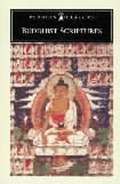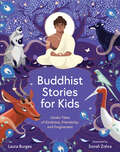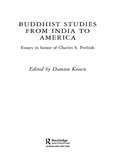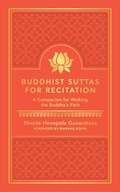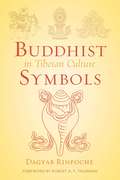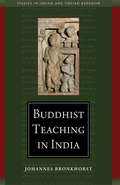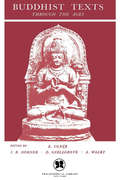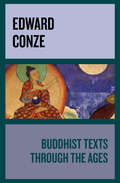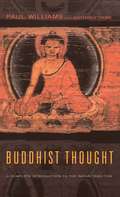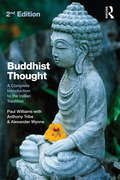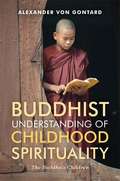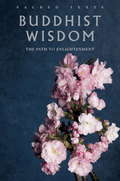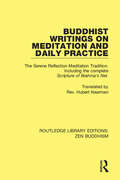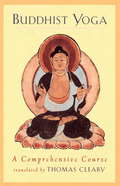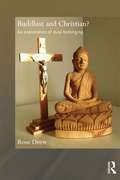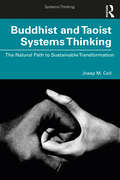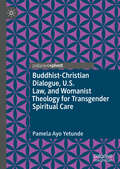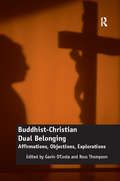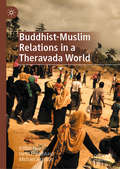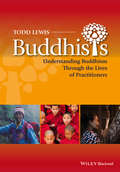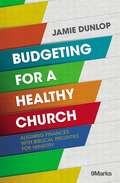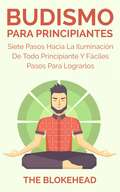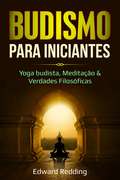- Table View
- List View
Buddhist Scriptures
by Edward ConzeBuddhism is divided into numerous traditional schools, each with its own set of Scriptures. This selection of essays concentrates on the central tradition of Buddhism, at the expense of the more peripheral developments, on that which is common rather than that which separates.
Buddhist Stories for Kids: Jataka Tales of Kindness, Friendship, and Forgiveness
by Laura BurgesA wise and colorful collection of ten Buddhist fables, this modern telling of ancient Indian stories, centering around animals and nature, teaches vibrant and timeless life lessons. (Ages 4-8)Long ago, the Buddha told his followers Jataka Tales, or &“birth stories,&” about the many lifetimes he lived before he was born as Prince Siddhartha. In this beautiful retelling of ten such stories, the Buddha is introduced as the Queen of the Dogs, a loyal Parrot, a mischievous Monkey, a wise Lion, a brave Forest Owlet, and more. Each story conveys important morals that are short, sweet, and to the point, giving children a handful of useful lessons to apply to their lives, like &“Always try to do the right thing, even when no one else is watching.&” These tales are brought to life with stunning and dreamlike illustrations by Sonali Zohra (illustrator of Ashoka the Fierce), exploring in vivid detail how one&’s actions affect others; the importance of kindness; the strength of friendship; the value of thoughtful decisions; and the importance of letting go and learning to forgive. With a beautiful paper-over-board package to tie it all together, this book will serve as a timeless and treasured offering for both children and adults.
Buddhist Studies from India to America: Essays in Honor of Charles S. Prebish (Routledge Critical Studies in Buddhism)
by Damien KeownBuddhist Studies from India to America covers four important areas of Buddhist Studies: Vinaya Studies and Ethics, the history of Buddhist schools, Western Buddhism, and Inter-religious dialogue. These are the main areas which Charles S. Prebish has either inaugurated or helped to define; and his academic career as a leading, international scholar, and his significant professional achievements are celebrated within this volume. The geographical and historical scope of the essays in this collection range from ancient India to modern America, and includes contributions by well-known international scholars. The contributors discuss a variety of academic disciplines including philosophy, psychology, history, feminism, and sociology. It will appeal to scholars whose interests embrace either ancient or modern aspects of the Buddhist tradition.
Buddhist Suttas for Recitation: A Companion for Walking the Buddha's Path
by Bhante GunaratanaA lavishly produced book featuring carefully chosen selections from the Buddha’s teachings for use in recitation and reflection.Buddhist Suttas for Recitation provides everything you need to begin and maintain a practice of contemplative recitation and reflection. These practices will deepen your connection to the Buddha, strengthen your faith in the Path, and nurture your intellectual understanding of the Dhamma. This unique volume includes carefully chosen discourses of the Buddha from the Pali Canon—presented in inspiring and accessible English with accompanying Pali—that convey the essence of the Dhamma. The introductory material explains the relationship between meditation and devotional practice, offers instructions on setting up a home altar, and gives advice on how to use these texts to enhance your spiritual development.
Buddhist Symbols in Tibetan Culture: An Investigation of the Nine Best-Known Groups of Symbols
by Robert Thurman Maurice Walshe Loden Sherap Dagyab RinpocheIn this fascinating study, Dagyab Rinpoche not only explains the nine best-known groups of Tibetan Buddhist symbols but also shows how they serve as bridges between our inner and outer worlds. As such, they can be used to point the way to ultimate reality and to transmit a reservoir of deep knowledge formed over thousands of years.
Buddhist Teaching in India
by Johannes BronkhorstThe earliest records we have today of what the Buddha said were written down several centuries after his death, and the body of teachings attributed to him continued to evolve in India for centuries afterward across a shifting cultural and political landscape. As one tradition within a diverse religious milieu that included even the Greek kingdoms of northwestern India, Buddhism had many opportunities to both influence and be influenced by competing schools of thought. Even within Buddhism, a proliferation of interpretive traditions produced a dynamic intellectual climate. Johannes Bronkhorst here tracks the development of Buddhist teachings both within the larger Indian context and among Buddhism's many schools, shedding light on the sources and trajectory of such ideas as dharma theory, emptiness, the bodhisattva ideal, buddha nature, formal logic, and idealism. In these pages, we discover the roots of the doctrinal debates that have animated the Buddhist tradition up until the present day.
Buddhist Texts Through the Ages
by Edward ConzeEdward Conze presents the premier anthology of Buddhist texts and scriptures in this stunningly ambitious collection. He traces the development of Buddhism through the ages, with translations from the original Pali, Sanskrit, Chinese, Tibetan and Japanese. For those looking for the perfect companion to Conze's original text, Buddhism, or for those new to Buddhist theology, Buddhist Texts Through the Ages contains a thorough and comprehensive guide to the theology. This edition also includes a glossary of English and foreign terms. Edward Conze was an English scholar and translator who was famous for his translations of Buddhist texts, particularly his 1951 tome Buddhism. He taught at the University of London and the University of Oxford. He lived in Oxford, England until his death in 1979.
Buddhist Texts Through the Ages
by Edward ConzeThe renowned scholar and translator presents an enlightening anthology of Buddhist writings that trace the development of Buddhism across the centuries. Edward Conze was one of the most important Buddhist scholars of the twentieth century, producing numerous influential translations of his own. In Buddhist Texts Through the Ages, Conze presents one of the most comprehensive anthologies of Buddhist writing ever published. The evolution of Buddhist philosophy and theology is represented through a wealth of original texts, all newly translated for this volume. Covering the breadth of Buddhist traditions, this volume incudes works translated from Pali, Sanskrit, Chinese, Tibetan, and Japanese. An ideal companion to Conze&’s essential text, Buddhism, this edition also includes a glossary of English and foreign terms.
Buddhist Thought in India: Three Phases of Buddhist Philosophy (Routledge Library Editions: Buddhism)
by Edward ConzeOriginally published in 1962. This book discusses and interprets the main themes of Buddhist thought in India and is divided into three parts: Archaic Buddhism: Tacit assumptions, the problem of "original Buddhism", the three marks and the perverted views, the five cardinal virtues, the cultivation of the social emotions, Dharma and dharmas, Skandhas, sense-fields and elements. The Sthaviras: the eighteen schools, doctrinal disputes, the unconditioned and the process of salvation, some Abhidharma problems. The Mahayana: doctrines common to all Mahayanists, the Madhyamikas, the Yogacarins, Buddhist logic, the Tantras.
Buddhist Thought: A Complete Introduction to the Indian Tradition
by Paul Williams Alexander Wynne Anthony TribeBuddhist Thought guides the reader towards a richer understanding of the central concepts of classical Indian Buddhist thought, from the time of Buddha, to the latest scholarly perspectives and controversies. Abstract and complex ideas are made understandable by the authors' lucid style. Of particular interest is the up-to-date survey of Buddhist Tantra in India, a branch of Buddhism where strictly controlled sexual activity can play a part in the religious path. Williams' discussion of this controversial practice as well as of many other subjects makes Buddhist Thought crucial reading for all interested in Buddhism.
Buddhist Thought: A Complete Introduction to the Indian Tradition
by Paul Williams Alexander Wynne Anthony TribeBuddhist Thought guides the reader towards a richer understanding of the central concepts of classical Indian Buddhist thought, from the time of Buddha, to the latest scholarly perspectives and controversies. Abstract and complex ideas are made understandable by the authors' lucid style. Of particular interest is the up-to-date survey of Buddhist Tantra in India, a branch of Buddhism where strictly controlled sexual activity can play a part in the religious path. Williams' discussion of this controversial practice as well as of many other subjects makes Buddhist Thought crucial reading for all interested in Buddhism.
Buddhist Understanding of Childhood Spirituality: The Buddha’s Children
by Alexander Von GontardIn this book, Alexander von Gontard, a child psychiatrist, uses the language, thought and imagery of Buddhism to explore the spirituality of children. The book begins by exploring the Buddha's own childhood and the 'divine child' in Buddhism, a key archetype in Jungian psychology. The author defines the spirituality and religiosity of children and adolescents and identifies manifestations of spirituality in children, such as experiences of awe and wonder, and favourable conditions for spirituality, such as silence, nature, extreme conditions and mindfulness. Drawing on his own experience working with children in therapeutic practice, von Gontard discusses the parallels between spontaneous spirituality seen in childhood and the Buddha's teachings. Revealing how the spiritual insights and experiences of children and adolescents can uncover a deep and wise understanding of human life that is compatible with the Buddha's teachings, this book will be of particular interest to professionals and academics in psychology, psychiatry, psychotherapy, education and religious studies.
Buddhist Wisdom
by Gerald BenedictDiscover the ancient wisdom that has made Buddhism the most popular non-Biblical religion in Europe and North America.
Buddhist Writings on Meditation and Daily Practice: The Serene Reflection Tradition. Including the complete Scripture of Brahma's Net (Routledge Library Editions: Zen Buddhism)
by Hubert NearmanThis book, first published in 1994, is a compendium of new translations of certain works regarded as fundamental texts in the Serene Reflection Buddhist Tradition (S?t? Zen). All the texts were in Chinese, either as original works or as translations from Sanskrit. Several of them are central to the ceremonial not only of the S?t? Zen Tradition but also of other Mahayana Buddhist traditions as well.
Buddhist Yoga: A Comprehensive Course
by Thomas ClearyThe word yoga has many meanings, including "meditation," "method," and "union." While the physical exercises of Hindu yoga are familiar to Westerners, the subtle metaphysics and refined methods of spiritual development that characterize Buddhist yoga are not yet well known. This volume presents a landmark translation of a classical sourcebook of Buddhist yoga, the Sandhinirmochana-sutra, or "Scripture Unlocking the Mysteries," a revered text of the school of Buddhism known as Vijnanavada or Yogachara. The study of this scripture is essential preparation for anyone undertaking meditation exercise. Linking theory and praxis, the scripture offers a remarkably detailed and thorough course of study in both the philosophical and pragmatic foundation of Buddhist yoga, and their perfect, harmonious union in the realization of Buddhist enlightenment.
Buddhist and Christian?: An Exploration of Dual Belonging (Routledge Critical Studies in Buddhism)
by Rose DrewThe last century witnessed a gradual but profound transformation of the West's religious landscape. In today's context of diversity, people are often influenced by, and sometimes even claim to belong to, more than one religious tradition. Buddhism and Christianity is a particularly prevalent and fascinating combination. This book is the first detailed exploration of Buddhist Christian dual belonging, engaging - from both Buddhist and Christian perspectives - the questions that arise, and drawing on extensive interviews with well-known individuals in the vanguard of this important and growing phenomenon. The book looks at whether it is possible to be authentically Buddhist and authentically Christian given the differences in beliefs and practices. It asks whether Buddhist Christians are irrational, religiously schizophrenic or spiritually superficial; or whether the thought and practice of Buddhism and Christianity can be reconciled in a way that makes possible deep commitment to both. Finally, the book considers whether the influence of Buddhist Christians on each of these traditions is something to be regretted or celebrated.
Buddhist and Taoist Systems Thinking: The Natural Path to Sustainable Transformation (Systems Thinking)
by Josep M. CollBuddhist and Taoist Systems Thinking explores a radical new conception of business and management. It is grounded on the reconnection of humans with nature as the new competitive advantage for living organizations and entrepreneurs that aspire to regenerate the economy and drive a positive impact on the planet, in the context of the Anthropocene. Organizations today struggle in finding a balance between maximizing profits and generating value for their stakeholders, the environment and the society at large. This happens in a paradigm shift characterized by unprecedented levels of exponential change and the emergence of disruptive technologies. Adaptability, thus, is becoming the new business imperative. How can, then, entrepreneurs and organizations constantly adapt and, at the same time, design the sustainable futures they’d like? This book uniquely explores the benefits of applying Buddhist and Taoist Systems Thinking to sustainable management. Grounded in Taoist and Zen Buddhist philosophies, it offers a modern scientific perspective fundamentally based on the concepts of bio-logical adaptability and lifefulness amidst complexity and constant change. The book introduces the new concept of the Gaia organization as a living organism that consciously helps perpetuate the conditions for life on the planet. It is subject to the natural laws of transformation and the principles of oneness, emptiness, impermanence, balance, self-regulation and harmonization. Readers will find applied Eastern systems theories such as the Yin-Yang and the Five Elements operationalized through practical methodologies and tools such as T-Qualia and the Zen Business model. They are aimed at guiding Gaia organizations and entrepreneurs in leading sustainable transformations and qualifying economic growth. The book offers a vital toolkit for purpose-driven practitioners, management researchers, students, social entrepreneurs, evaluators and change-makers to reinvent, create and mindfully manage sustainable and agile organizations that drive systemic transformation.
Buddhist-Christian Dialogue, U.S. Law, and Womanist Theology for Transgender Spiritual Care
by Pamela Ayo YetundeThis book, written with hospital spiritual care providers in mind, investigates how to expand the field and scope of compassion within the hospital context, for the spiritual care and safety of transgender patients. Written by a law-educated pastoral counselor, it advocates for chaplain legal literacy, and explains the consequences of spiritual care providers not knowing more about the law. It explores the current political and legal situation transgender hospital patients find themselves in, and especially how these new policies put transgender people at risk when they are in a hospital setting. Pamela Ayo Yetunde offers Buddhist-Christian activist interreligious dialogue methods to promote deeper understanding of how spiritual practices can cultivate empathy for transgender patients.
Buddhist-Christian Dual Belonging: Affirmations, Objections, Explorations
by Gavin D'Costa Ross ThompsonA growing number of people describe themselves as both Buddhist and Christian; but does such a self-description really make sense? Many people involved in inter-faith dialogue argue that this dialogue leads to a mutually transformative process, but what if the transformation reaches the point where the Buddhist or Christian becomes a Buddhist Christian? Does this represent a fulfilment of or the undermining of dialogue? Exploring the growing phenomenon of Buddhist-Christian dual belonging, a wide variety of authors including advocates, sympathisers and opponents from both faiths, focus on three key questions: Can Christian and Buddhist accounts and practices of salvation or liberation be reconciled? Are Christian theism and Buddhist non-theism compatible? And does dual belonging inevitably distort the essence of these faiths, or merely change its cultural expression? Clarifying different ways of justifying dual belonging, contributors offer criticisms of dual belonging from different religious perspectives (Theravada Buddhist, Evangelical Reformed and Roman Catholic) and from different methodological approaches. Four chapters then carry the discussion forward suggesting ways in which dual belonging might make sense from Catholic, Theravada Buddhist, Pure-land Buddhist and Anglican perspectives. The conclusion clarifies the main challenges emerging for dual belongers, and the implications for interreligious dialogue.
Buddhist-Muslim Relations in a Theravada World
by Iselin Frydenlund Michael JerrysonThis book is the first to critically analyze Buddhist-Muslim relations in Theravada Buddhist majority states in South and Southeast Asia. Asia is home to the largest population of Buddhists and Muslims. In recent years, this interfaith communal living has incurred conflicts, such as the ethnic-religious conflicts in Myanmar, Sri Lanka, and Thailand. Experts from around the world collaborate to provide a comprehensive look into religious pluralism and religious violence. The book is divided into two sections. The first section provides historical background to the three countries with the largest Buddhist-Muslim relations. The second section has chapters that focus on specific encounters between Buddhists and Muslims, which includes anti-Buddhist sentiments in Bangladesh, the role of gender in Muslim-Buddhist relations and the rise of anti-Muslim and anti-Rohingya sentiments in Myanmar. By exploring historical fluctuations over time—paying particular attention to how state-formations condition Muslim-Buddhist entanglements—the book shows the processual and relational aspects of religious identity constructions and Buddhist-Muslim interactions in Theravada Buddhist majority states.
Buddhists: Understanding Buddhism Through the Lives of Practitioners (Lived Religions)
by Todd LewisBuddhists: Understanding Buddhism through the Lives of Practitioners provides a series of case studies of Asian and modern Western Buddhists, spanning history, gender, and class, whose lives are representative of the ways in which Buddhists throughout time have embodied the tradition. Portrays the foundational principles of Buddhist belief through the lives of believers, illustrating how the religion is put into practice in everyday life Takes as its foundation the inherent diversity within Buddhist society, rather than focusing on the spiritual and philosophical elite within Buddhism Reveals how individuals have negotiated the choices, tensions, and rewards of living in a Buddhist society Features carefully chosen case studies which cover a range of Asian and modern Western Buddhists Explores a broad range of possible Buddhist orientations in contemporary and historical contexts
Buddho
by Ajahn Tate Thanissaro BhikkhuA simple and practical guide to the use of the meditation phrase buddho, which is used to settle the mind to the point at which discernment can begin to arise.
Budgeting for a Healthy Church: Aligning Finances with Biblical Priorities for Ministry (9Marks)
by Jamie DunlopMany pastors conceive of the church budget as primarily a financial tool, but in fact it is primarily a pastoral tool. A church's philosophy of ministry is locked into its budget, and so the budget will either stifle or accelerate any attempts to move a congregation toward a biblical model of church health. As such, the church budget is a far more potent pastoral tool than many church leaders realize. Budgeting for a Healthy Church examines each section of the budget in light of Biblical principles to show how a church budget can lock in healthy approaches to ministry. Whereas most books on church budgeting are "how" books, explaining how the budgeting process should work, this is a "what" book, helping church leaders determine the pastoral implications of what they choose to fund in their budgets.
Budismo Para Principiantes/ Siete Pasos Hacia La Iluminación De Todo Principiante.
by The BlokeheadBudismo fácil. Tu Vida Está A Punto de Mejorar Mucho. ¿Te sientes estresado? ¿Estás abrumado por las demandas diarias de tu vida y desearías estar más en paz y lograr concentración plena (mindfulness)? La Solución Para Tí. Budismo Para Principiantes- Siete Pasos Hacia la Iluminación de Todo Principiante y Fáciles Pasos Para Lograrlos. Este libro sirve como una forma de iluminación e información sobre el Budismo como un estilo de vida y como camino para estar mentalmente despierto. Un rápido vistazo del libro: ✔ Comprender las Cuatro Nobles Verdades ✔ Comprender el Noble Camino (Y Otros Caminos hacia la Iluminación) ✔ Aceptación ✔ Dejar ir ( No apegos) ✔ Y mucho, mucho más. ¡Para tener un acceso instantáneo, simplemente selecciona este libro para su compra! Author's biography: The Blokehead is an extensive series of instructional/how to books which are intended to present quick and easy to use guides for readers
Budismo para Iniciantes: Yoga budista, Meditação & Verdades Filosóficas
by Edward ReddingO Budismo é uma das mais antigas religiões que existem há milénios. Aqueles que seguem o caminho do Budismo acreditam que é mais uma filosofia do que uma religião, e se dedicam inteiramente aos ensinamentos do Buda e às lições localizadas no Cânon Pāli. Essa vasta escola de conhecimento é aquela que apresenta mais de 84.000 ensinamentos do próprio Buda e incontáveis outros Budas que desde então seguiram o caminho da iluminação. Para o budista, escolher seguir o seu próprio caminho de iluminação, é uma jornada sagrada e poderosa para se seguir. A jornada inclui inúmeras oportunidades para se conectar mais profundamente com a sabedoria do universo e a natureza de si mesmo e do mundo que o/a rodeia. Por isso, é dito que você aprofunda as suas experiências de bom karma e encontra o caminho para a forma mais verdadeira de nirvana, ou iluminação. Se você está aqui lendo isso, posso apenas imaginar que você está interessado em descobrir mais sobre o Budismo, ou mesmo em se comprometer com o caminho. Bem-vindo/a! Descobrir os ensinamentos do Buda e aprender sobre como o Budismo funciona e o que ele pretende alcançar é uma jornada maravilhosa, assim como o caminho de refúgio, se você optar por seguir esse caminho. Aprender a incorporar a filosofia budista na sua própria vida é uma oportunidade maravilhosa para você descobrir as lições poderosas dessa filosofia e obter o valor delas na sua vida quotidiana. Dentro do Budismo para Iniciantes, você descobrirá tudo o que precisa saber sobre o Budismo, seja como um novo devoto ou como alguém que está simplesmente explorando a religião. Cada capítulo é projetado para lhe dar uma abundância de conhecimento sobre o que realmente é o Budismo, como funciona e como as pessoas se dedicam a esse caminho. Parte do que você descobrirá neste poderoso texto inclui: A história do Budismo, incluindo suas origens e como se transformou no que é hoje
